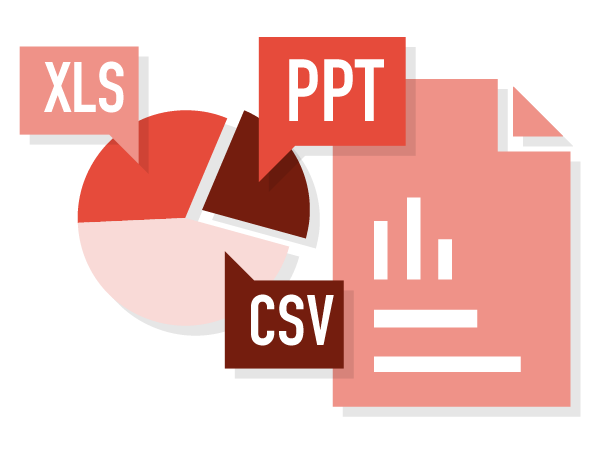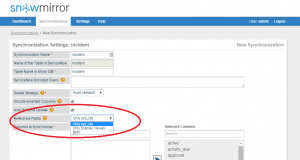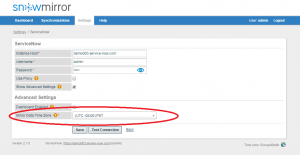 During our Las Vegas stay at Knowledge15 we have collected a number of ideas and feature requests. Some of them were mentioned and voted several times. Our agile development team was able to add the most important features into the next release and today we proudly announce a general availability of SnowMirror 2.7. The highlights are: Display value replication and Mirror DB timezone setup (a.k.a. timestamp conversion). Both of the features will help to make reports on ServiceNow data even easier.
During our Las Vegas stay at Knowledge15 we have collected a number of ideas and feature requests. Some of them were mentioned and voted several times. Our agile development team was able to add the most important features into the next release and today we proudly announce a general availability of SnowMirror 2.7. The highlights are: Display value replication and Mirror DB timezone setup (a.k.a. timestamp conversion). Both of the features will help to make reports on ServiceNow data even easier.
Display Value Replication
 ServiceNow stores the data in a 3rd normal form. It means that references to other entities (tables) are stored as foreign keys which mean a cryptic sys_id pointing to a record in the other table. Imagine a caller of an incident. The field caller_id does not contain a name of the caller as you would expect from the UI form. It contains a sys_id of the caller user account record. This whole concept is pretty well known to technical users and DB guys. But how about the business users that need just a simple report using Excel or Tableau? SnowMirror 2.7 has a solution.
ServiceNow stores the data in a 3rd normal form. It means that references to other entities (tables) are stored as foreign keys which mean a cryptic sys_id pointing to a record in the other table. Imagine a caller of an incident. The field caller_id does not contain a name of the caller as you would expect from the UI form. It contains a sys_id of the caller user account record. This whole concept is pretty well known to technical users and DB guys. But how about the business users that need just a simple report using Excel or Tableau? SnowMirror 2.7 has a solution.
The synchronization setup now allows to choose different Reference Fields strategies:
- Only sys_ids – original option, pure mirror of the underlying ServiceNow database. Reference fields contain sys_ids of the referenced records. E.g. caller_id contains a sys_id of a user record
- Display Values – reference fields contain display values. E.g. caller_id contains a name of the caller user
- Both – original columns contain sys_ids and new columns prefixed with dv_ contain the display values. E.g. caller_id contains a sys_id of the user record and dv_caller_id contains a name of the user.
To get the display values of referenced records please use the last two options. It’s up to you and your requirements which strategy suits you better. Please note that the display value strategies are not perfect. If the referenced display value changes SnowMirror has no chance to be notified about this change. E.g. caller name (not the caller itself) changes from John Smit to John Smith. The incident referencing John will contain the old value until the incident itself is updated and the value gets updated as well.
Time Zone Setup
 Another intensively requested feature. ServiceNow API always returns timestamps in the UTC timezone. And SnowMirror was always storing them in the same way. However ServiceNow users are used to see the dates in their own time zone in the ServiceNow user interface. Moreover the ODBC driver or exports work with the user’s time zone too.
Another intensively requested feature. ServiceNow API always returns timestamps in the UTC timezone. And SnowMirror was always storing them in the same way. However ServiceNow users are used to see the dates in their own time zone in the ServiceNow user interface. Moreover the ODBC driver or exports work with the user’s time zone too.
SnowMirror implements a new feature which allows to configure a global mirror time zone and all the timestamps are converted from UTC into this target time zone. Please note that after changing this setting, the existing data is not converted. A Clean&Sync command is needed.
Note that there is an advanced property snowMirror.mirrorTable.storeDateTimeWithLocalTimezone since SnowMirror 2.5 which allows to use special data types preserving time zone information. So since SnowMirror 2.7 there are even more strategies how to work with time zones.
Other Features And Fixes
- Added progress bars for long running tasks – Bulk Create and Import
- Fixed data truncation exceptions – SnowMirror failed to synchronize columns which referenced to several values which resulted in error “Data truncation: Data too long.” From now on this error is fixed.
- Fixed: SnowMirror failed to store big Decimal values to mirror database. For that cases it now uses a bigger precision.
- Fixed: Corrupted synchronizations were not editable and delete attempts failed
- Improved activity logs for easier debugging
- Several minor bug fixes and improvements